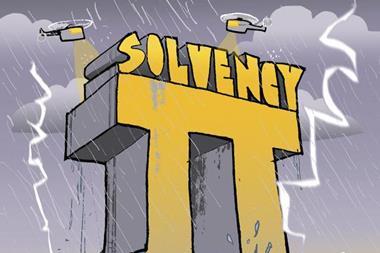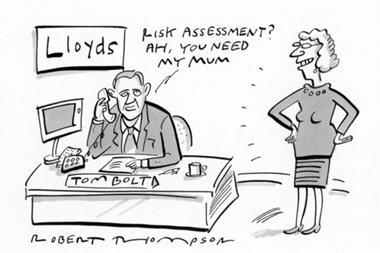Solvency II may not be popular with insurers, but Ceiops’ secretary-general, a key figure behind its shaping, wants a little recognition for the ‘vast amount’ of work his committee has done
Carlos Montalvo Rebuelta has just seen his native Spain win its first World Cup, a victory that came on top of the triumph of Athletico Madrid – the self-confessed football nut’s home team – in May’s Europa League final.
If only things had been as smooth at the office for the Ceiops secretary-general, whose key role in shaping the Solvency II insurance directive makes him one of the European industry’s key figures.
Over the past few months, Ceiops (the Committee of European Insurance and Occupational Supervisors and the umbrella body for EU member states’ insurance and pensions regulators), has received quite a roasting from an insurance industry unhappy with its advice on how the new directive should work.
Companies are warning that the draft specification for Quantitative Impact Study 5 (QIS5) – the directive’s final test run – will mean having to hold between 30% and 50% more capital on their balance sheets than under the existing Solvency I regime.
At a public hearing on Solvency II, held in Brussels two months ago, Montalvo appeared irritated by the negative feedback.
The heavily accented lawyer with a nice line in self-deprecating humour today denies that he has allowed the criticism to get under his skin.
“I wouldn’t call it irritation; I would say it’s a lack of recognition. You can like or not like the outcome of what we have proposed; you can say we have been too prudent.
“But we feel that there hasn’t been recognition of the vast amount of work that Ceiops has done.”
He defends the committee’s recommendations, which he says were drawn up in response to “extremely tight deadlines” and were based on rigorous analysis of the best available data.
Montalvo can’t say the same of the European Commission’s subsequent watering down of Ceiops’ advice. “Some of the changes that we have seen have not been based on an equivalent amount of technical work,” he says.
He is worried by the changes, warning that they “undermine the concept of the risk-based system”. The critics’ brickbats have been misplaced, he argues, because the proposed new risk-based regime is a very different beast to the existing Solvency I framework, based as it is on premiums or recent claims.
“They are basing their analysis on Solvency I, which is not a sound basis of comparison. If you want to analyse on the basis of Solvency I, you need to look not only at capital requirements.
“When you introduce more risks, the capital charge will be higher.”
Ceiops is not driven by a desire to erect a failure-free framework, he insists.
“As supervisors, we don’t want an overly prudent system that is less efficient. Prudency is an end not a means; we don’t want to create a system that doesn’t work as well as it should.”
He admits that Ceiops’ own supervisors were taken aback by the higher than anticipated capital requirements that their findings delivered.
“What was put out for consultation was more prudent than what we as supervisors would have liked,” he says.
And while he acknowledges that Ceiops’ “main objective is the protection of policyholders”, the European insurance sector’s wider competitiveness is an “important factor to be borne in mind”. The industry runs in Montalvo’s blood – his grandfather was the chair of a prominent Spanish mutual.
“We need to find a balance. You can say that supervisors were too prudent in terms of capital requirement, but do we want to go to the other side of the pendulum and have an under-capitalised system?”
Noting the intense pressure on the banking system to introduce greater prudence, he suggests that it is better for the insurance sector to come up with a solution that is not driven by politicians.
“A non-prudent system is a time bomb when times are harsh. That would have future implications for the insurance sector, which would affect the good guys and the bad guys. It would have a devastating impact on policyholders and would probably lead to a political reaction.
“We don’t want a system that is insufficiently prudent. It’s in the best interests of everybody that we find a balance and create a system that does not need to be reviewed.”
If the pilot can demonstrate insurers’ ability to meet the directive’s test of 99.5% solvency over a 100-year period, he will be happy.
But Solvency II, while a massive undertaking, is not the only issue in Montalvo’s in-tray. Later this year, the organisation will be put on to a more formal footing when it mutates into the European Insurance and Occupational Pensions Authority (Eiopa).
Montalvo, who will take over the top job at the new body, says the authority will have stronger powers than the present, looser arrangements.
But in the meantime, Ceiops will focus on the broking sector with the revision of the Intermediaries Directive, or IMD for short. UK brokers are concerned that the shake-up will result in mandatory fees disclosure.
Montalvo is tight-lipped on what Ceiops will recommend to the commission.But he hints that the wider political climate means greater transparency is on the cards.
“There is the whole issue of the political debate that has emerged since the (financial) crisis and whether there has or hasn’t been sufficient transparency.
“Everybody, in the debate, be they consumers, regulators or brokers, agrees that there has to be more transparency. The issue is how much and what type.”
And pointing to a print of his fellow Spaniard Diego Velázquez’s painting, ‘The Toilet of Venus’, which depicts the goddess of love as a reclining nude, he observes that the industry should not fear being similarly “naked” in front of its regulator.
But Solvency II looks likely to remain the hottest topic for Montalvo.
And the prize will be worth the heartache, he insists, strongly urging insurers to participate in QIS5, which Ceiops will run.
“We want to make sure that QIS5 is successful. Solvency II is a unique opportunity to create a much higher degree of harmonisation than what we have at the moment and that can only be to the benefit of policyholders.” IT






































No comments yet